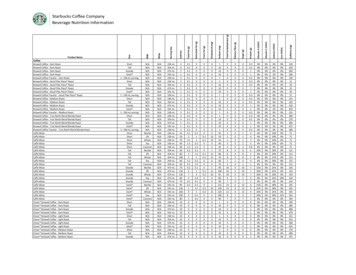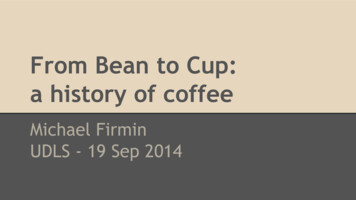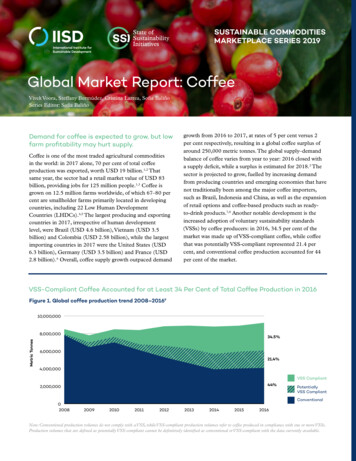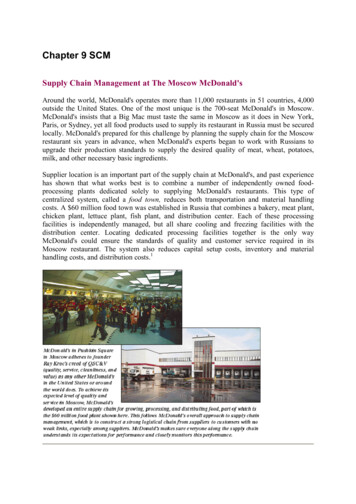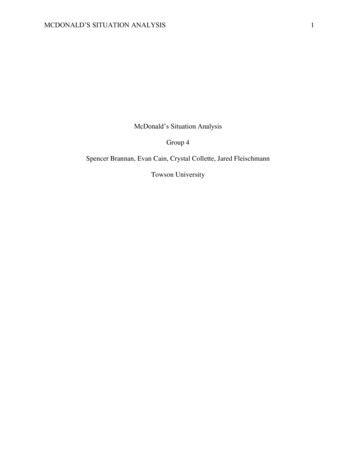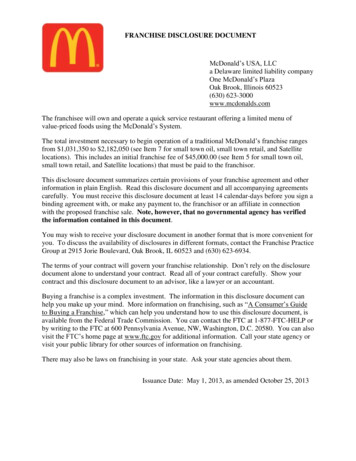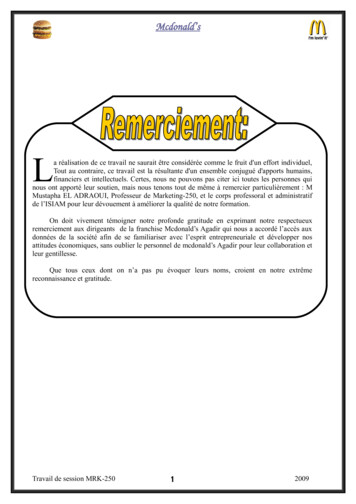
Transcription
And Now,The RestOf TheStory . . .By Kevin G. Cain*The McDonald’sCoffee Lawsuit14Journal of Consumer & Commercial Law
Somehow, somewhere along the way, theMcDonald’s coffee lawsuit became the posterchild for frivolous lawsuits. Who hasn’t takena crack at this lawsuit for the sake of furtheringtheir own cause? David Letterman andnumerous other comedians have exploitedthis case as the punch-line to countless jokes.1One of my favorite Seinfeld episodes involves Cosmo Kramersuing Java World after Kramer spills a cup of café latté onhimself while trying to get a seat at a movie theater.2 Kramersuffers from minor burns that are easily remedied after asingle application of a balm given to Kramer by the Maestro.Kramer asks his favorite attorney, Jackie Chiles, if the factthat he tried to sneak the coffee into the theater is going tobe a problem in their lawsuit. Jackie responds, “Yeah, that’sgoing to be a problem. It’s gonna be a problem for them.This is a clear violation of your rights as a consumer. It’s aninfringement on your constitutional rights. It’s outrageous,egregious, preposterous.”3 When Kramer asks if this lawsuithas a chance, Jackie responds, “Do we have a chance? Youget me one coffee drinker on that jury, you gonna walk outtathere a rich man.”4 Of course, Elaine is less than supportivewhen she finds out about Kramer’s latest lawsuit and quips,“What I mean is who ever heard of this anyway? Suing acompany because their coffee is too hot? Coffee is supposedto be hot.”5 Obviously, Jerry and company are taking theirown shots at the McDonald’s lawsuit in particular, and atfrivolous lawsuits in general.It seems that nearly everyone has an opinion aboutfrivolous lawsuits. This author recently removed a boxcontaining class handouts sitting on the floor in the middle ofan entryway into a Bible classroom and asked the person whoput the box there if he minded my moving the box becausesomeone could accidentally get hurt. The person responded(knowing that I was an attorney) by simply snorting as hewalked away, “I think everyone who files a frivolous lawsuitshould be shot.” “Objection, non-responsive,” I thought, butyou get the point. All too often there does not appear to bemuch we can do to change people’s opinions on this subject.Or is there?“Just the facts ma’am; just the facts.” A line madefamous by Dragnet’s Sergeant Joe Friday may be the answer.Unfortunately, people often refuse to let the facts alter theirpoints of view. “I have my opinion, and I won’t let truth,reality, or the facts get in the way.”6 However, if peoplereally knew the true facts about the McDonald’s lawsuit, fewwould have the same opinion (or misconception) that theycarry around today. Let’s be honest. Most people, attorneysincluded, know little to nothing about the infamousMcDonald’s lawsuit other than the last joke they heard aboutit. A woman spilled some McDonald’s coffee on herself, gotburned, and got millions of dollars. That is about all most ofus know about this woman and her legendary lawsuit. Andyet many uninformed people have very strong opinions onthis case. Well, as Paul Harvey says, “And now, the rest of thestory.”Liebeck v. McDonald’s Restaurants7Seventy-nine-year-old Stella Liebeck of Albuquerque,New Mexico, was sitting in the passenger seat when hergrandson drove his car through a McDonald’s drive-thruwindow in February 1992.8 Liebeck ordered coffee thatwas served in a McDonald’s styrofoam cup.9 After receivingthe order, the grandson pulled his car forward and stoppedfor his grandmother to add sugar and cream to her coffee.10Journal of Consumer & Commercial Law(The rumors of Liebeck spilling her coffee while drivingwere inaccurate.11 The car was not moving, and she was notdriving.) While parked, Ms. Liebeck placed the cup betweenher knees and attempted to remove the plastic lid from thecup.12 As she attempted to remove the lid, the contents ofthe cup spilled onto her lap.13 The coffee was estimated to besomewhere between 180 to 190 degrees.14 Ms. Liebeck waswearing sweatpants that day, which absorbed the scorchingcoffee, holding it next to her skin.15 A vascular surgeondiagnosed Liebeck as having suffered full thickness burns(or third-degree burns)16 over her inner thighs, perineum,buttocks, and genital and groin areas.17 These third degreeburns extended through to Liebeck’s subcutaneous fat, muscle,or bone.18 While she was hospitalized for eight days, Liebeckunderwent skin grafting, and later underwent debridement19treatments.20 Liebeck was permanently disfigured anddisabled for two years as a result of this incident.21Ms. Liebeck, a retired department store clerk, informedMcDonald’s of her accidentand requested that McDonald’spay for her medical expensestotaling approximately 11,000.McDonald’s refused.22 With noother recourse in sight, Ms. Liebeckretained a Houston attorneynamed Reed Morgan who hadfiled a similar hot-coffee lawsuitagainst McDonald’s in 1986.23Mr. Morgan’s prior case againstMcDonald’s involved a Houstonwoman who suffered third-degreeburns from McDonald’s coffee.24In that 1986 case, Mr. Morgandeposed Christopher Appleton,a McDonald’s quality assurancemanager, who testified that “hewas aware of this risk . . . and had no plans to turn down theheat.”25 McDonald’s settled that case for 27,500.26Before filing suit, Liebeck requested that McDonald’spay 90,000 for Liebeck’s medical expenses and pain andsuffering.27 McDonald’s countered with a generous offer of 800.28 Ms. Liebeck had never filed a lawsuit before in herlife, and she said she never would have filed this lawsuit ifMcDonald’s “hadn’t dismissed her request for compensationfor pain and medical bills with an offer of 800.”29Ms. Liebeck brought suit against McDonald’s in 1993alleging that the coffee she purchased was defective becauseof its excessive heat and because of inadequate warnings.30Punitive damages were also sought based on the allegationthat McDonald’s acted with conscious indifference for thesafety of its customers.31 As the trial date neared, Liebeck’sattorney offered to settle the case on her behalf for 300,000and reportedly would have settled for half that amount.32 Amediator recommended a 225,000 settlement on the eve oftrial, but McDonald’s again refused any attempt to settle.33Evidence at trial was simply damning. It was learnedthat McDonald’s was aware of more than 700 claims broughtagainst it between 1982 and 1992 due to people being burnedby its coffee.34 Some of these claims involved third-degreeburns that were substantially similar to the burns sufferedby Liebeck.35 Moreover, McDonald’s had previously spentover 500,000 in settling these prior coffee-burn claims.36In spite of the knowledge of these claims and this inherentdanger with its coffee, McDonald’s refused to change itscorporate policy and serve its coffee at a safer temperature.37We have probablyall heard someonesay, “Watch out! at coffee is hot.You could have alawsuit on yourhands.”15
McDonald’s own quality assurance managertestified that McDonald’s enforced a policy requirement thatall coffee be served at 185 degrees, give or take five degrees.38He also admitted that its coffee was not “fit for consumption”because it would cause scalding injuries to the mouth andthroat if drunk by the consumer.39Q: [Y]ou know, as a matter of fact, that coffee is ahazard, selling it at 180 to 190 degrees, don’t you?A: I have testified before, the fact that this coffeecan cause burns.Q: It is hazardous at this temperature?A: At that high temperature the coffee is a hazard.Q: If customers attempt to swallow that coffee, isn’tit a fact that it will scald their throat or esophagus?A: Yes, under those conditions, if they could getthe coffee in their throat, that could happen, yes. . . 40The same McDonald’s quality assurance managercontinued to testify, illustrating McDonald’s culpability:Q: So. . . when somebody buys a cup of coffeeand it’s sold to them at McDonald’s and they go tosit down and drink it in less than five minutes, it’snot fit for consumption to drink, if consumptionmeans to drink? . . .A: It’s perfectly fit to open the top and add creamand sugar and really dilute the product as far astemperature goes and it probably would be very fitfor consumption . . . .Q: If you don’t mind getting burned it’s fit forconsumption. My question is, is it fit to be drunk,actually fluid going down your esophagus?A: I think I already answered that.Q: And the answer is no, it’s not, isn’t it?A: Yes, we answered that.41Although coffee at various temperatures has thecapacity to inflict burns, the problem with McDonald’s coffeeis the fast rate at which it could cause such serious burns.McDonald’s own expert testified that coffee served above130 degrees could produce third degree burns; therefore,McDonald’s argued, it did not matter whether its coffeewas served at 180 to 190 degrees.42 However, this argumenthas some serious flaws that the plaintiff exploited. Charles16Baxter, Liebeck’s expert in thermodynamics as applied to skinburns, testified that liquids can cause full thickness (thirddegree) burns to skin in two to three seconds at 190 degrees,in 12 to 15 seconds at 180 degrees, and in 20 seconds at160 degrees.43 Obviously, if Liebeck’s coffee had been servedjust a little less scalding, vital seconds could have beenadded to her response time to allow her to get out of hergrandson’s car and disrobe to prevent more serious burnsfrom occurring. Unfortunately, Ms. Liebeck had only abouttwo or three seconds before third-degree burns set in, and theinstantaneous damage was already done. Plaintiff’s warningsexpert, Lila Laux, testified that while people know that coffeeis hot, they do not know how severe (i.e., third-degree) theseburns can be and how quickly the burns can set in.44An obvious question needs to be asked at this point.Why did McDonald’s make their coffee so hot? If this dangerof scalding customers was known andcould be easily remedied, then why notsimply reduce the temperature of itscoffee? That question was answered attrial. McDonald’s requires that its coffeebe prepared at scalding temperatures,based on the recommendations ofcoffee consultants and industry groupswhich claim that hot temperatures arenecessary to fully extract the full coffeeflavor during the brewing process.45McDonald’s operations and trainingmanual states that its coffee must be brewed at 195 to 205degrees and held at 180 to 190 degrees for optimal taste.46Keep in mind that water boils at 212 degrees Fahrenheit.Hence, the reason for preparing the coffee at near-boilingtemperatures was to optimize the taste. Besides, one billionannual McDonald’s coffee drinkers cannot all be wrong, canthey?McDonald’s knew that its coffee was being served atextremely hot temperatures, but market research told themthat McDonald’s customers “want hot coffee, they want itsteamy hot, and they expect to get it that way.”47 McDonald’sindifference to customer safety is evident in the followingtestimony from McDonald’s quality assurance manager:Q: Isn’t it a fact that back in 1988, when I showedyou the pictures of the young lady that was burned inthat situation, that you were appalled and surprisedthat coffee could cause that kind of burn?A: Yes, I had never seen photographs like thatbefore.Q: All right. In those six years, you still havenot attempted, yourself, or know of anyone withinthe corporation that has attempted to find out therate of speed, the lack of margin of safety in servingcoffee at this temperature right . . . .A: No, we have not.48Evidenceat trial wassimplydamning.McDonald’s continued to demonstrate thissame corporate indifference. McDonald’s human factorsengineer, Dr. P. Robert Knaff, testified that the number ofhot coffee burns that occur are “statistically insignificant”when compared to the billion cups of coffee McDonald’ssells annually.49 This callousness was further demonstratedby the testimony of McDonald’s quality assurance manager,who stated:Q: So a fair way to assess your reasoning is, “A fewpeople are being seriously burned with deep secondand third degree burns requiring hospitalization,Journal of Consumer & Commercial Law
but out of the billions of cups of coffee we sell,there’s not been enough burned to where we needto stop selling it that hot?”A: There’s a very low probability of an accident asa result of using the product and we know that thecustomers want the product hot so we’re at this timecontinuing with our current practice. . . .Q: Mr. Appleton, do you know how McDonald’sCorporation informs itself of the severity of theburns that are recorded on Plaintiff’s Exhibit No. 3?Do you know what they do to ascertain how seriousthose burns are?A: I’m not intimately familiar with the process.I believe it’s handled through our insurancecompany.Q: So for you to say that you haven’t formulated aconclusion that there have been enough severe burnsto warrant turning down the temperature on yourcoffee, you are speaking without knowledge of theextent and severity of the burns that were reflectedin those computer printouts, is that right?A: I think that I don’t think we have a goodmeasure of the severity of each of these.Q: Well, I’m curious because I’ve shown yourecordations here of some 700 people here that havebeen burned. Obviously, to you 700 people burnedis not a significantly high enough number to turndown the heat. Do you have in mind a numberof how many people would have to be burned foryou to become so concerned that you would insistthat burn specialists be consulted and something bedone to sell this coffee at a lower temperature?A: No, I don’t have a number in mind.50At trial, McDonald’s argued that Liebeckcontributed to her own injuries by placing the coffee cupbetween her legs and by not removing her clothing promptlyafter the spill.51 McDonald’s further alleged that the severenature of the burns suffered by Ms. Liebeck were worse thanusual because of her older skin making her more vulnerableto more serious injuries.52 A McDonald’s executive testifiedthat McDonald’s had chosen not to warn its customers of thepossible severe burns its coffee could cause because “(t)here aremore serious dangers in restaurants.”53 McDonald’s humanfactors engineer admitted that the number of hot coffeeburns suffered by McDonald’s customers are “statisticallyinsignificant” in comparison to the one billion cups of coffeesold by McDonald’s each year.54The jury deliberated after hearing seven days ofevidence, testimony, and arguments of counsel, finding thatMcDonald’s was liable on the claims of product defect, breachof the implied warranty of merchantability, and breach ofthe implied warranty of fitness for particular purpose.55 Thejury further determined that Ms. Liebeck’s injuries meritedan award of 200,000 compensatory damages.56 However,because the jury found that Ms. Liebeck was 20% at fault,that award was reduced proportionately to 160,000.57Finally, the jury awarded Ms. Liebeck 2.7 million in punitivedamages based on its finding of willful, reckless, malicious,or wanton conduct.58 The amount of 2.7 million wasarrived at based on evidence the jury heard that McDonald’sdaily coffee revenues amounted to approximately 1.34million.59 These exemplary damages represented about twodays worth of McDonald’s coffee revenues.60 However, afact that rarely ever makes headlines (in this case, or in anyJournal of Consumer & Commercial Lawallegedly “fraudulent” lawsuit) is that the punitive damageswere reduced by the trial court to 480,000 (three times thecompensatory damages) for a total award of 640,000.61Judge Robert H. Scott, who presided over this trial, stated inregard to the reduced punitive damages award:I think that there was evidence andargument about the Defendant’s knowledge that thecoffee could cause serious, third degree, full tissueburns. The Defendant McDonald’s knew that thecoffee, at the time it was served, was too hot forhuman consumption . . . .[T]he written transcript is not goingto reveal the attitudes of corporate indifferencepresented by demeanor or of the witnesses for theDefendant McDonald’s as well as their employees,but the jury was exposed to it and I think that theyproperly considered it in their deliberations. Andlet me say that with knowing the risk of harm,the evidence and testimony would indicate thatMcDonald’s consciously made no serious effort towarn its consumers by placing just the most simple,adequate warning on the lid of the cup in which thecoffee was served. . . . This is all evidence of culpablecorporate mental state and I conclude that the awardof punitive damages is and was appropriate to punishand deter the Defendant for their wanton conductand to send a clear message to this Defendant thatcorrective measures are appropriate.62Judge Scott ordered the parties to engage in a postverdict settlement conference which resulted in a settlementof the case for an undisclosed amount (less than 600,000)which remains confidential. Ms. Liebeck’s case was dismissedwith prejudice on November 28, 1994.63McDonald’s has taken some remedial measures inthe aftermath of the Liebeck lawsuit. Many McDonald’sdrive-thrus now have a sign warning, “Coffee, tea and hotchocolate are VERY HOT!” Also,the lids of McDonald’s hot beveragecups are now embossed with thewords “HOT! HOT! HOT!” Itis debatable whether the coffee atMcDonald’s is served any coolerthan the coffee that injured Ms.Liebeck. Some sources indicatethat McDonald’s current policy isto serve coffee between 175-195degrees Fahrenheit.64 The industrystandard still calls for near boilingtemperatures for the best-tastingcoffee.65 It appears that the currentreaction to coffee lawsuits is to do abetter job of warning, but maintainthe temperature for better tastingjava.What can be learned from this case? First, theMcDonald’s coffee case is not a frivolous lawsuit, as manypeople believe. In fact, Ms. Liebeck had a very strong caseagainst a very unsympathetic corporate defendant. Anargument can obviously be made that the punitive damagesshould not have been decreased, especially in light of thepurpose of punitive damages. A judgment of 480,000certainly would not be the same deterrent as 2.7 million.Second, our profession can and must do our part tohelp change the public perception of our legal system.Our professioncan and mustdo our part tohelp changethe publicperception ofour legal system.17
Far too many have the misconception that if anyinsignificant, trivial misfortune happens to someone, theaffected person can manipulate the legal system until he orshe finally strikes gold. That simply is not the case. Ourlegal system has numerous checks and balances and controlmeasures in place that deter and penalize frivolous lawsuitsand curb excessive jury verdicts. Our legal system works; andthose who degrade and twist our profession by spreading halftruths and distorting reality, sadly align themselves with thosewho have exploitedtheignoranceinduced fear ofothers throughouthistory. It is trulyamazing how thetruth can changeperspectives.“But whatif they won’t listento me?”66 Just likeMoses at the burningbush,wemayneed a little extraammunitionforthe mission ahead.Well, here it is. Thenext time someoneis indulging in thelatest pastime of“lawyer-bashing,” challenge that person by saying, “I’ll betyou probably think that the McDonald’s coffee lawsuit was afrivolous lawsuit, don’t you?” After they accept the challengeto your seemingly indefensible position, you can then beginto (politely) dismantle their perception of the poster child,cornerstone, and personification of frivolous lawsuits byinforming them of “the rest of the story” behind Liebeck v.McDonald’s Restaurants.In the Federalist Papers, Alexander Hamilton wroteof “the effects of those ill humors, which the arts of designingmen, or the influence of particular conjectures, sometimesdisseminate among the people themselves, and which,though they speedily give place to better information, andmore deliberate reflection, have a tendency, in the meantime,to occasion dangerous innovations in the government, andserious oppressions of the minor party in the community.”67By educating people, one on one, about the facts in Liebeckv. McDonald’s Restaurants, it is possible to begin dismantlingthe public’s perception of frivolous lawsuits and change themisconceptions about our profession and our legal system.Our legal system hasnumerous checks andbalances and controlmeasures in place thatdeter and penalizefrivolous lawsuits andcurb excessive juryverdicts.* Kevin G. Cain is a senior counsel with the law firm ofMartin, Disiere, Jefferson & Wisdom, L.L.P. in the businesslitigation and appellate sections. He is a moot court coach forSouth Texas College of Law and was a two-time national mootcourt champion while attending South Texas College of Law.He can be reached at (713) 632-1700 or cain@mdjwlaw.com. A version of this article first appeared in the HoustonLawyer.1. The Late Show with David Letterman (CBS televisionbroadcast, Jun. 29, 1995) (“Top Ten List, Dr. KevorkianTips for Summer: Number Four. Take a bunch of friends toMcDonald’s and pour scalding coffee on each other.”)2. Seinfled: The Maestro.3. Id.184. Id.5. Id.6. We all know that politicians generally would not exploitthe media’s twisted version of current events to furthertheir own agenda, but it does happen occasionally. See 140CONG. REC. H9766 (Sept. 27, 1994) (statement of Rep.John Kasich, OH, R.) (“Everybody in America is fed up withbeing sued by everybody for everything. I just have to referto the case of the lady that sued and won for having beenscalded by a cup of coffee she bought in McDonald’s fiveminutes earlier.”)7. No. CV 93 02419, 1995 WL 360309 (Bernalillo County,N.M. Dist. Ct. Aug. 18, 1994).8. Andrea Gerlin, A Matter of Degree: How a Jury DecidedThat a Coffee Spill Is Worth 2.9 Million, WALL ST. J., Sept.1, 1994, at A1.9. Mark B. Greenlee, Kramer v. Java World: Images, Issues,and Idols in the Debate Over Tort Reform, 26 CAP. U. L.REV. 701, 718 (1997); Hot Coffee Spill Worth Cool Award,McDonald’s May Fork Over 2.9 Million, DENV. POST, Aug.19, 1994, at A12.10. Greenlee, Kramer v. Java World, 26 Cap. U. L. Rev. at718.11. Rick Van Warner, The Legal Wheel of Fortune is SpinningOut of Control, NATION’S RESTAURANT NEWS, Sept. 12, 1994,at 47 (“[D]oesn’t common sense count for anything anymore?Is it really McDonald’s fault that a customer decided totake the lid off a full, hot cup of coffee while she was behindthe wheel of an auto?”); George F. Will, Elevating Newt,Depreciating Chesty, and Other Wonders of 1994, NEWSWEEK,Dec. 26, 1994, at 134 (“A jury awarded 2.9 million to awoman who burned herself when, in a moving car, leaving aMcDonald’s with a cup of coffee between her legs, she spilledit.”); Java Jive, Miami Herald, Aug. 27, 1994, at 30A (“Yetshe opened it in a car and prepared to drive – hardly the safestplan for drinking any hot beverage.”).12. Greenlee, Kramer v. Java World, 26 Cap. U. L. Rev. at718.13. Id.14. Id.15. Id.16. Third degree burns are burns that penetrate the dermis(skin) and go down to the underlying tissue. See WEBSTER’SNEW EXPLORER MEDICAL DICTIONARY, 698 (MerriamWebster, Inc., Springfield, MA, 1999). Go to www.google.com and click on “Images” and type in “third-degree burns.”After you stop dry-heaving at these pictures, please return toreading this article.17. Keith H. Hammonds, McDonald’s Hot Coffee Gets HerCool Cash, BUSINESS WEEK (Sept. 5, 1994).18. Greenlee, Kramer v. Java World, 26 CAP. U. L. REV. at718.19. Debridement is defined as the “surgical removal oflacerated, devitalized, or contaminated tissue” or, moresimply, “the removal of dead tissue to expose living tissue.”WEBSTER’S NEW EXPLORER MEDICAL DICTIONARY, 161.“Debridement is the process of removing dead skin andforeign or waste material from the burned area” and “isnormally a very painful process.” DeMary v. United States,982 F.Supp. 1101, 1105 n.4 (D. S.C. 1997).20. Greenlee, Kramer v. Java World, 26 CAP. U. L. REV. at718-19; Gregory Nathan Hoole, In the Wake of SeeminglyExorbitant Punitive Damage Awards America Demands Capson Punitive Damages—Are We Barking Up the Wrong Tree?, 22J. CONTEMP. L. 459, 470 (1996).Journal of Consumer & Commercial Law
21. Greenlee, Kramer v. Java World, 26 CAP. U. L. REV. at718.22. Gerlin, A Matter of Degree, WALL ST. J., at A1; Hoole, AreWe Barking Up the Wrong Tree?, 22 J. CONTEMP. L. at 470.23. Gerlin, A Matter of Degree, WALL ST. J., at A1.24. Id.25. Id.26. Id.27. Greenlee, Kramer v. Java World, 26 CAP. U. L. REV. at719.28. Gerlin, A Matter of Degree, WALL ST. J., at A1; Hoole, AreWe Barking Up the Wrong Tree?, 22 J. CONTEMP. L. at 471.29. Gerlin, A Matter of Degree, WALL ST. J., at A1; Greenlee,Kramer v. Java World, 26 CAP. U. L. REV. at 719.30. Id.31. Greenlee, Kramer v. Java World, 26 CAP. U. L. REV. at719.32. Gerlin, A Matter of Degree, WALL ST. J., at A1; Greenlee,Kramer v. Java World, 26 Cap. U. L. Rev. at 719.33. Id.34. Consumer News, Large Award Chills Restaurant ServingHot Coffee, 7 LOY. CONSUMER L. REP. 2, 2 (1994); Gerlin, AMatter of Degree, WALL ST. J., at A1; Hoole, Are We BarkingUp the Wrong Tree?, 22 J. CONTEMP. L. 470-71.35. Consumer News, Large Award Chills Restaurant ServingHot Coffee, 7 LOY. CONSUMER L. REP. 2, 2 (1994); Gerlin, AMatter of Degree, WALL ST. J., at A1.36. Id.37. See Greenlee, Kramer v. Java World, 26 CAP. U. L. REV.at 720-21.38. Id. a 719.39. Id. at 719-20; Ralph Nader & Wesley J. Smith, NOCONTEST: CORPORATE LAWYERS AND THE PERVERSION OFJUSTICE IN AMERICA, at 270 (1996) (quoting the Liebecktranscript).40. Nader & Smith, supra note 39 (quoting the Liebecktranscript).4.1 See Greenlee, Kramer v. Java World, 26 CAP. U. L. REV.at 719-20.42. Id. at 720; Gerlin, A Matter of Degree, WALL ST. J., atA1.43. Id.44. Greenlee, Kramer v. Java World, 26 CAP. U. L. REV. at720.45. Consumer News, 7 LOY. CONSUMER L. REP. 2, 2 (1994);Gerlin, A Matter of Degree, WALL ST. J., at A1.Journal of Consumer & Commercial Law46. Gerlin, A Matter of Degree, WALL ST. J., at A1.47. Greenlee, Kramer v. Java World, 26 CAP. U. L. REV. at720-21.48. Nader & Smith, NO CONTEST, at 271 (quoting theLiebeck transcript).49. Greenlee, Kramer v. Java World, 26 CAP. U. L. REV. at721.50. Id. at 722.51. Consumer News, 7 LOY. CONSUMER L. REP. at 2; Gerlin,A Matter of Degree, WALL ST. J., at A1; Hoole, Are We BarkingUp the Wrong Tree?, 22 J. CONTEMP. L. at 471; Hoole, Are WeBarking Up the Wrong Tree?, 22 J. CONTEMP. L. at 471.52. Consumer News, 7 LOY. CONSUMER L. REP. at 2; Gerlin, AMatter of Degree, WALL ST. J., at A1; Hoole, Are We BarkingUp the Wrong Tree?, 22 J. CONTEMP. L. at 471.53. Gerlin, A Matter of Degree, WALL ST. J., Sept. 1, 1994,at A1.54. Greenlee, Kramer v. Java World, 26 CAP. U. L. REV. at721.55. 1995 WL 360309 (N.M. Dist. Ct. Aug. 18, 1994).56. Id.57. Id.58. Greenlee, Kramer v. Java World, 26 CAP. U. L. REV. at722.59. Id.; Hot Coffee Spill Worth Cool Award, DENV. POST, Aug.19, 1994, at A12.60. Hot Coffee Spill Worth Cool Award, DENV. POST, Aug. 19,1994, at A12.61. Daniel J. Shapiro, Punitive Damages, 43 LA. B.J. 252,254 n.1 (1995).62. Nader & Smith, NO CONTEST, at 272 (1996) (quotingthe Liebeck transcript).63. Shapiro, Punitive Damages, 43 LA. B.J. at 254 n.1.64. See Liebeck v. McDonald’s Restaurants, coffee case; Burger Chain Sued After Boy’sOrdeal, CAMBRIDGE EVENING NEWS, 23 June2007, . McMahon v. Bunn-O-Matic Corp., 150 F.3d 651, 65859 (7th Cir. 1998); Holowaty v. McDonald’s Corp., 10F.Supp.2d 1078, 1081 (D. Minn. 1998).66. Exodus 4:1.67. THE FEDERALIST PAPERS NO. 78 (Alexander Hamilton).19
Coffee Lawsuit And Now, The Rest Of The Story . . . By Kevin G. Cain* Journal of Consumer & Commercial Law Journal of Consumer & Commercial Law 15 S omehow, somewhere along the way, the McDonald’s coffee lawsuit became the poster child for frivolous lawsuits. Who hasn’t tak

